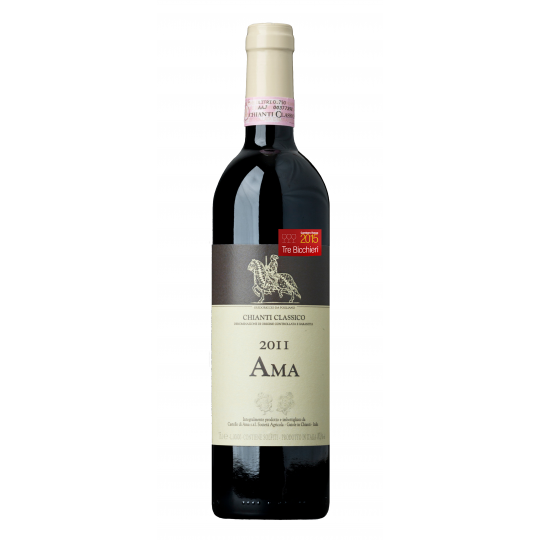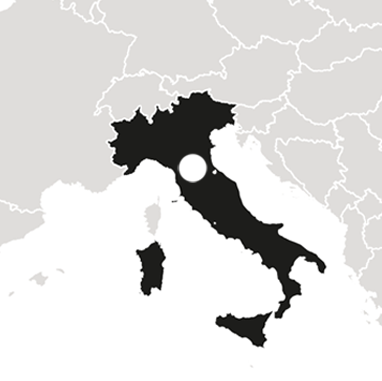Waarom deze wijn?
Chianti Classico is Castello di Ama! Geen enkel ander Chiantihuis weet zo subliem het prachtige Chianti Classico terroir in hun wijnen over te brengen. Wij zijn oprecht blij dat we de hand hebben weten te leggen op de laatste flessen van hun mooiste jaargang 2011, bekroond met 3 glazen (!) in de Gambero Rosso.
De smaak
Groot enthousiasme is opgewekt voor deze pure, prachtige traditionele Chianti Classico. De wijn is robijnrood, subtiel kruidig en veel diepte in het fruit, goed geproportioneerde smaak, krachtig, elegante structuur, intense afdronk.
De details
type wijn: full bodied, verfijnd en complex
druivensoort: 96% Sangiovese, 4% Merlot
teelt: biologisch
opvoeding: 12 maanden op eiken houten vaten, 1 jaar op fles
alcoholgehalte: 13,00 % vol.
afsluiting: natuur kurk
drinktemperatuur: 16-18 graden
bewaarpotentieel: 2027
spijs-aanbeveling: vlees- roodvlees, gegrild of geroosterd, lams- en schapenvlees, wild, kaas- gerijpte kazen
De prijzen elders?
Wij vergelijken het voordeel altijd met de prijzen in de online-markt. Belangrijk is dat er dan wel 'appels met appels' worden vergeleken; dus precies dezelfde wijn per 6 flessen van (bij voorkeur) hetzelfde jaar èn bij jou thuisbezorgd (de bezorgtarieven elders zijn meegenomen in de prijscheck).
Chianti Classico Ama 2011 is in Nederland via twee andere aanbieders te verkrijgen. Gemiddeld ligt het prijsniveau elders op € 30,95.
De oorsprong
'At Castello di Ama, the connection to the local territory always comes first, and Chianti Classico has always been the basic product in this estate run by Lorenza Sebasti and Marco Pallanti. The style has always been the most important feature of Ama wines.' Gambero Rosso 2015
Slimme weetjes: Chianti van weleer
A Chianti wine [?kjanti] is any wine produced in the Chianti region, in central Tuscany, Italy. It was historically associated with a squat bottle enclosed in a straw basket, called a fiasco. however, the fiasco is only used by a few makers of the wine now; most Chianti is now bottled in more standard shaped wine bottles. Baron Bettino Ricasoli (later Prime Minister of the Kingdom of Italy) created the Chianti recipe of 70% Sangiovese, 15% Canaiolo and 15% Malvasia bianca in the middle of the nineteenth century.
From Wikipedia, the free encyclopedia.
Slimme weetjes: het hart van Chianti is Chianti Classico
The first definition of a wine-area called Chianti was made in 1716. It described the area near the villages of Gaiole, Castellina and Radda; the so-called Lega del Chianti and later Provincia del Chianti (Chianti province). In 1932 the Chianti area was completely re-drawn and divided in seven sub-areas: Classico, Colli Aretini, Colli Fiorentini, Colline Pisane, Colli Senesi, Montalbano and Rùfina. Most of the villages that in 1932 were suddenly included in the new Chianti Classico area added in Chianti to their name-such as Greve in Chianti which amended its name in 1972. Wines labelled "Chianti Classico" come from the biggest sub-area of Chianti, that includes the original Chianti heartland. Only Chianti from this sub-zone may boast the black rooster seal (known in Italian as a gallo nero) on the neck of the bottle, which indicates that the producer of the wine is a member of the Chianti Classico Consortium, the local association of producers.
From Wikipedia, the free encyclopedia.
Slimme weetjes: Welke druiven mogen in een Chianti
During the 1970s producers started to reduce the quantity of white grapes in Chianti. In 1995 it became legal to produce a Chianti with 100% Sangiovese. For a wine to retain the name of Chianti, it must be produced with at least 80% Sangiovese grapes. Aged Chianti (38 months instead of 4–7), may be labelled as Riserva. Chianti that meets more stringent requirements (lower yield, higher alcohol content and dry extract) may be labelled as Chianti Superiore, although Chianti from the "Classico" sub-area is not allowed in any event to be labelled as "Superiore".
From Wikipedia, the free encyclopedia.


